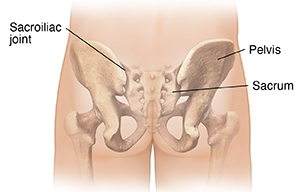Understanding Sacroiliac Strain
A joint is a place where 2 bones meet. The 2 sacroiliac joints are where the hip (iliac) bones meet the bottom part of the spine (sacrum). These joints are surrounded by muscle, connective tissue, and nerves. Normally, a sacroiliac joint (SIJ) doesn't move very much. But it can be pushed out of alignment. The tissues around an SIJ also can be stretched or torn. This can lead to pain in the low back.

How to say it
SAK-roh-EE-lee-ak strain
Causes of sacroiliac strain
Causes of SIJ strain can include:
-
Stress on the SIJ from lifting weight incorrectly
-
Poor body mechanics and posture during sports or work activities
-
Damage from degenerative diseases such as arthritis
-
Increased pressure on the SIJ from pregnancy or obesity
Symptoms of sacroiliac strain
Symptoms of SIJ strain may include:
-
Aching in the low back, buttocks, or upper leg
-
Pain that gets worse with movement or standing for a long time, and gets better with rest
-
Inability to move as freely as normal
-
Muscle spasms in the low back
Treating sacroiliac strain
Treatment focuses on reducing pain and preventing further injury. Treatments may include:
-
Prescription or over-the-counter medicines. These help reduce pain and swelling. NSAIDs (nonsteroidal anti-inflammatory drugs) are the most common medicines used. Medicines may be prescribed or bought over the counter. They may be given as pills. Or they may be put on the skin as a gel, cream, or patch.
-
Cold packs or heat packs. These help reduce pain and swelling.
-
Stretching and other exercises. These improve flexibility and strength.
-
Physical therapy. This may include exercises or other treatments.
-
An SIJ belt. This medical device is worn around the hips, to make the SIJ more stable and reduce pain.
-
Shots (injections) of medicine. This may relieve symptoms. The medicine is often a corticosteroid. This is a strong anti-inflammatory medicine.
Possible complications of sacroiliac strain
If the cause of the pain is not addressed, symptoms may return or get worse. Follow your healthcare provider’s instructions on lifestyle changes and treating your SIJ strain.
When to call your healthcare provider
Call your healthcare provider right away if you have any of these:
-
Fever of 100.4°F (38°C) or higher, or as advised by your provider
-
Chills
-
Redness or swelling
-
Pain that gets worse
-
Symptoms that don’t get better with prescribed medicines, or get worse
-
New symptoms
© 2000-2024 The StayWell Company, LLC. All rights reserved. This information is not intended as a substitute for professional medical care. Always follow your healthcare professional's instructions.